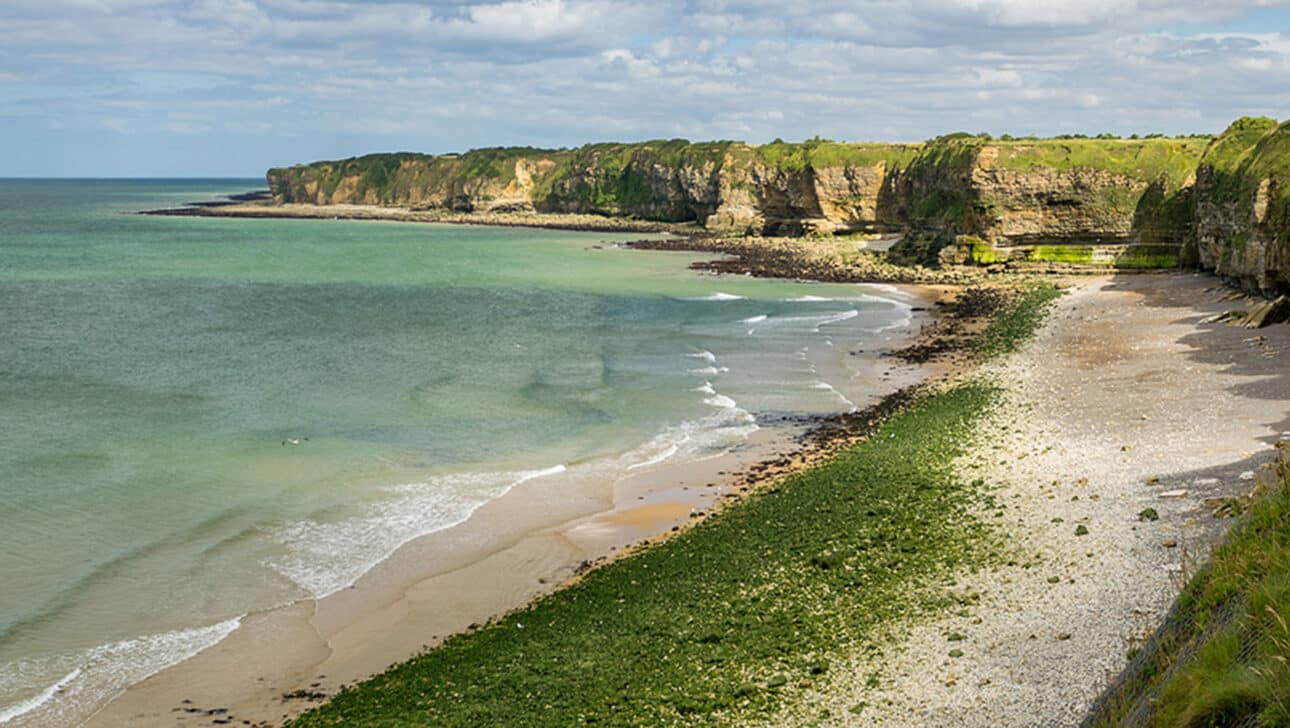This year, D-Day will be honoring its 75th anniversary… and the memories still feel fresh.
I went to Normandy imagining I could focus on sipping calvados with my Camembert, decoding the Bayeux tapestry, and walking a cow path through a tufted pasture to a 400-year-old barn that’s still in use.
Theoretically, I suppose, that’s possible. If the beach had never been code-named Omaha. If bunkers didn’t still frown from the brow of oceanside bluffs. If that high wooded meadow were just a meadow and not the achingly beautiful American Cemetery…If, if, if, then Normandy would be nothing more than a gorgeous getaway destination. Of course, it’s so much more.
When I travel, I fully expect to make memories. But it turns out that Normandy and Brittany are more about the chemistry of remembering, about tapping into a collective history that’s astonishingly vivid even if you are a bit fuzzy on the details.
The people here who lived through it all certainly can’t forget the period of occupation, invasion and liberation. When I asked Dominique, our friend and local guide, how D-Day is remembered here, she told me a story of innocence skipping under the radar. “During the occupation, my grandparents would send my mother—then just a child—to the village on silly little errands. ‘Why this purchase? Why this shop?’ she remembers thinking. Only much later did she grasp that she was actually delivering secret messages to aid the local Resistance.”
She remembers the stories of her father who was supposed to scour the sky for American and British planes, but who went “blind” if he actually saw one. Resistance fighters knew they could hide at the family’s stud farm. “The people don’t speak of it so much now,” she adds. As long ago as the 50th Anniversary of D-Day in 1994, none of the teenagers interviewed in Argentan realized that their town was so devastated that only 21 homes survived. Still, the stories are there to be teased out gently, and Dominique makes sure we hear them as we spend time with the locals.
The places and facts of the great invasion aren’t so shy. Consider Arromanches. The Norman coast had no harbors large enough for the invasion force; those that did exist were heavily defended by the Germans. So the Allies built enormous caissons in England, filled them with 600,000 tons of cement and tugged them across the Channel. Deployed offshore at Arromanches, they formed an artificial harbor through which 2.5 million soldiers, 500,000 vehicles and 4 million tons of supplies passed. Today, as you stand on a lookout over the beach, the last of them still tilt above the waves, like a stubborn salute to ingenuity. The local museum built to memorialize the “débarquement” is one of the most interesting I’ve ever visited.
Omaha Beach, on the other hand, bears virtually no trace of the epic landing. It’s surprisingly quiet; today, you find a few cottage rentals here and there, but the blue water is too cool to be a major draw. The people of this region always lived with the beach to their backs, as farmers and dairymen rather than sailors and fishermen. The broad, flat expanse of sand is just soft enough that you’re tempted to take off your shoes. And then you flash to G.I.’s splashing their way onto it in combat boots, heavily laden with their weapons. To stand ankle-deep in that sand—back to the water, facing the bluffs that were lined with wall-to-wall firepower—is a moment that etches itself in your imagination.
If you’re on alert, the vestiges of Operation Overlord are everywhere. Road signs point to Caen and Saint-Lo, towns that were burned into the headlines. It seems that every village has a commemorative statue, fountain or plaque. Markers along quiet rural lanes note the progress of the liberation forces. You can duck into the stark German bunkers, staring fixedly at the flat horizon that bristled with ships on that morning in late spring. I don’t even know how to capture the feeling as the shadow of a lone cloud floats across the Cemetery as Taps echoes in the air. Words are too small to say what it means.
The D-Day sites can be heroic and beautiful, humble and humbling, serene and fascinating and inspirational. In the end, that’s even more the case because they co-exist alongside rich cultural sites that aren’t primarily about World War II. There’s Mont-St.-Michel, soaring over the sea as it has since the 15th Century. In Bayeux—one of the rare cities in these parts that was spared from bombing—the 230-foot-long tapestry portrays the Norman Conquest. And believe me, there is plenty of time for long, sunny farmhouse lunches, where the cider and calvados flow.
In the end, Normandy affected me like I had never predicted. I’m no war buff, yet I came away with a real sense of the scope and near-cosmic grandeur of the undertaking. I felt how much it means to preserve the memories of a time that for many of us is still only a generation or two away. I will always remember it.




